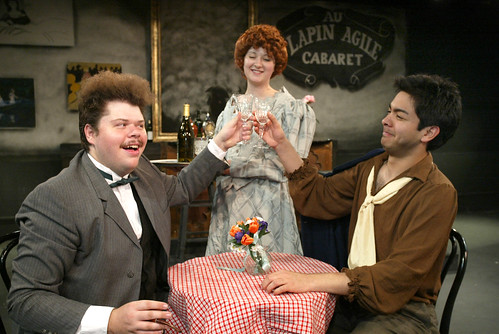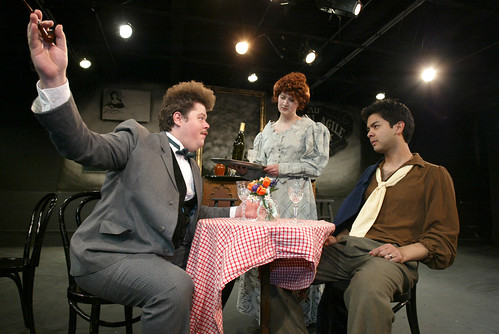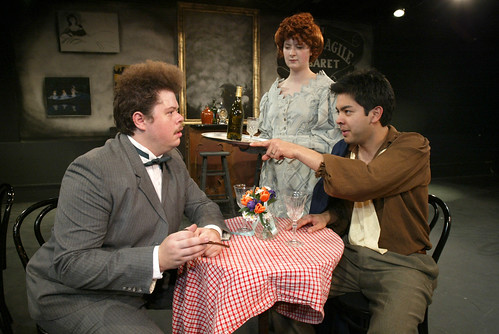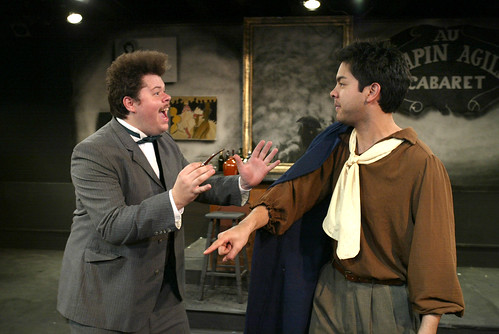through Oct. 29 on the Main Stage
There are three moments in the first act of the Civic's current production of My Fair Lady (through Oct. 29) that convince us that we're in for an evening of entertainment that's accomplished in its own right, distinct from whatever Hepburn-and-Harrison memories we may retain from the 1964 movie. Because make no mistake, mate, director Troy Nickerson and his talented cast have stepped up to one of the highest peaks in American musical theater and nearly reached the top. Despite some second-act flatness and some deficiencies in one of the leads, the Civic's season opener is a visually attractive, sometimes raucous, often quite moving rendition of a beloved musical.
The first of those three moments arrives when Kendra Kimball as Eliza Doolittle emerges from behind the men's quartet to join in "Wouldn't It Be Loverly?" All any of us wants, after all, is a clean, well-lighted "room somewhere, / Far away from the cold night air." At the outset of a luminous performance, Kimball reminds us how much of this Lerner and Loewe show concentrates on simple pleasures: creature comforts, being cared for, learning generosity. With her face smudged above her red and black flower girl outfit and her Cockney bray in full evidence, Kimball engages in some delightful dance steps with her partners, then uses her beautiful, yearning soprano to depict the kind of world we all long for. It's a sequence that, as it should, puts us in the corner of the underdog flower girl.
The second moment comes when David Gigler as Eliza's father, Alfred Doolittle, spills drunkenly out of a pub, soon launching into "With a Little Bit of Luck." Almost unrecognizable underneath his long dustman's coat and bowler, Gigler makes a hilarious and irresponsible drunk. (Just as his daughter is going to be force-fed some phonetics and turned almost in spite of herself into a proper English lady, the amoral Doolittle finds himself nudged against his will into respectability. But that comes later.) No sooner has Gigler boasted that he gave his daughter the gift of life as if it were some major accomplishment but he's hitting her up for money, so he can have "a bit of liquid protection" before he faces Eliza's (unseen) mother. Whether he's wobbling drunkenly into other people's faces or trying to stifle Alfred's intestinal eruptions, Gigler creates a detailed and very funny comic portrait: wiping his sleeve, hogging chairs, toying with expensive instruments, hopping with the delight of a potbellied Bacchus who's light on his feet.
Gigler leads the chorus in some of Nickerson's and Ryan Callan's inventive choreography: step-slide swaying; some unexpected foot stomping; some square-dance moves; and gradual entries leading to a realistic town-square gathering of folks who are showing up just to see what this scalawag Doolittle is up to now. While the opening crowd scene (flower sellers outside Covent Garden) seemed tentative and slow, after that Nickerson and Callan have designed some natural-seeming dance sequences.
The "poor Professor Higgins" sequences are deftly handled, giving us a sense of how much time is passing as Eliza struggles with her language lessons, and there's a hairs-on-the-back-of-the-neck moment when Eliza finally learns how to enunciate all those vowels in "The Rain in Spain" -- and she, along with Thomas Heppler as Henry Higgins and Wes Deitrick as Col. Pickering, executes a Spanish-tinged dance of joy that's among this show's several sets of naturalistic movement.
But the third of the opening-act highlights arrives soon after in Kimball's rendition of "I Could've Danced All Night." She stretches her soprano to impressive heights -- and after a nearly anticlimactic moment when housekeeper Mrs. Pearce (Norilee Kimball, stately and imperious) drags Eliza off to bed, she reappears to repeat the chorus. With able support from Don Malpass on flute in Carol Miyamoto's five-piece pit band, Kendra Kimball croons with arms outstretched, isolated in a pin spot, operatic -- a vision of the kind of joy we'd all like to get out of life.
There are still more things to admire about the Civic's Lady. Peter Hardie's versatile set provides plenty of dark wooden furnishings for Higgins' study, serving as a half-dozen exteriors as well. Nik Adams provides opera posters and a far-off perspective of St. Paul's Cathedral that evokes the neighborhood right there 'round London Bridge.
Deitrick mines comedy out of the sidekick role: silly in a pith helmet, drinking too much when worried for Eliza's sake, modeling awkwardly for one of Eliza's "gowns," and lapsing into Eliza's dialect over dessert (asking for some "pline cike" and doing a masterful double-take).
Eliza's gowns alone would have made the costumes of Susan Berger and Jan Wanless outstanding -- but the list goes on, with men in wedding-cake suits, common laborers all grubby, a slew of color-coordinated servants in Higgins' household.
For the "Ascot Gavotte" horse race scenes, Berger and Wanless show off one elaborate black-and-white gown after another in what's clearly intended as the show's peak of couture. But all the Victorian vogueing slows down the pace -- and Adams' pastel tents on the backdrop curtain, while inviting in themselves, detract from the stark B&W colorless scheme. It's a misstep that slows a first act that's full of highlights.
There are twice as many memorable songs in the first half as there are after intermission, which goes a long way toward explaining why this Lady's second act felt emotionally flatter. But in a production that has many beautiful and thrilling moments, several of the less effective episodes congregated around Heppler as this show's Higgins. In the venerable Rex Harrison tradition, Heppler is talk-singing several of his numbers, which is fine. And he has the fussiness, the devil-may-care single-mindedness of a British academic who's been pampered for too long and immersed in the subtleties of his obscure specialization. Problems crop up in the first act in "I'm an Ordinary Man," when both the vocal and instrumental attacks on the chorus ("but put a woman in your life") were weak. On exit lines like "damn you!" and "let the hellcat freeze!" (both aimed at Eliza), Heppler wasn't convincing or irate enough.
Heppler is most interesting near the end, when he subtly allows the cracks in his self-satisfaction to show during the big argument with Eliza. Heppler doesn't quite catch the ambiguity of the medley of tunes (and emotions) that his character is supposed to express in among snippets of "You Did It" and "Without You" and the famous "I've Grown Accustomed to Her Face." The wavering -- will he surmount his own selfishness and grow in much the same way Eliza transformed herself? -- isn't quite there yet, but may well be in a month's time (by the end of this show's run). But Heppler does achieve real pathos -- in his finest moment of the entire evening -- when, caught in a pin spot, he makes the final refrain of "Accustomed to Her Face" feel like a breakthrough moment: At last, the confirmed bachelor isn't quite sure of just how confirmed he is -- a wonderful moment.
Aside from spine-tingling touches like that one -- and those three stellar snapshots from Act One -- there are other highlights in Act Two as well. Kimball reprises "Wouldn't It Be Loverly" at the same fire where she once warmed herself as a flower girl -- but this time, it's more poignant, because it's a vision of a dream of comfort and affection that she had within her grasp and lost. Kimball's ability to caress the notes and at the same time convey strong emotion convincingly is remarkable. While there was some staginess in her posing among the teacups during the argument with Higgins late in the show, usually Kimball acts convincingly and gracefully. Her Eliza isn't a performance that's merely "good for community theater." This is a performance that's just very good, period.
And the beauty of My Fair Lady is that it offers poignance like that -- right next to the raucousness of Gigler's Alfred Doolittle, who energizes the less satisfying second act with his "Get Me to the Church on Time" number. Dressed "like a ruddy pallbearer," he's risque with the girls, leading them in foot-stomping trios and side-to-side gallumphing that's a delight to watch.
George Bernard Shaw's century-old premise (in Pygmalion, the source for this musical) is dated now: We live in a culture in which bling and cars and flashy clothes are the status symbols. So what if Little Ms. Celebrity causes us to lose all respect for her the moment she opens her mouth? Americans don't go in for all this intellectual stuff -- we're not convinced that the way you pronounce your vowels or talk in general is anywhere near an indicator of character. But there is a way in which, after seeing the Civic's and Nickerson's My Fair Lady, that we do feel elevated. Eliza's ascent toward what is good and beautiful in life is a vision of our ideal, of the kind of home and happiness that we would all like to achieve in our lives. And Kendra Kimball's performance matches that kind of ideal.




